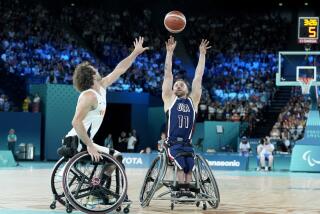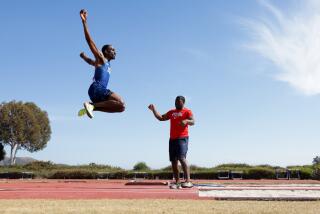On Oahu, people with physical or cognitive disabilities become surfers with an assist from this group
Surfing enthusiasts know that Oahu’s waters offer waves for every ability level.
Winter vacationers who are veteran surfers flock to the legendary North Shore; beginners hoping to catch their first wave stick to calmer waters in the south.
The disability community claims White Plains Beach, a serene park on leeward Oahu that has become ground zero for adaptive surfing.
At the heart of this surfing clan is AccessSurf, a small nonprofit that’s pioneering barrier-free ocean experiences for people with physical and cognitive disabilities.
“This is a program where everyone is accepted, everyone is included and everyone is very integrated,’’ said Cara Short, the executive director.
Vacationers can easily join the action, but be aware that spending one afternoon riding waves with these folks might get you hooked.
“They have become my ohana [family] from the moment I first met them, and they welcome me back every year with open arms,” Jeremy Levy of Parker, Colo., said in an email.
Levy, who is blind, said he couldn’t find anyone to teach him to surf until he connected with AccessSurf. Now his family schedules annual vacations around the organization’s Day on the Beach, a monthly event open to all. It’s usually the first Saturday of the month; check the organization’s event calendar as part of your trip planning.
If you go, you’ll be greeted with aloha spirit by a team of staff and volunteers — about 200 of them — whose passion and expertise have earned the program international acclaim. Serious competitors also travel to Oahu from all over the world to practice with this group.
Spike Kane, who has paralysis from the armpits down, regularly travels from Vista, Calif., to work out with AccessSurf.
“I already knew the mechanics of adaptive surfing, but I was only doing prone at the time,” he said, describing how he used to surf with a lot of assistance. “I didn’t know there was another way to adapt my board.”
Working with Short, he settled on a board modified with a chest riser to keep his head up and out of the water. With this adaptation, he was able to paddle out and push himself and his board up on a wave.
“I thought, ‘This is something I can do without a big load of people in the water panicking over me,’ ” he said. “From that moment on, I was, like, ‘This is the real deal. This is going to change my life.’ ”
Will adaptive surfing change your life? There’s only one way to know.
Arrive early, around 8 a.m., for orientation. Pre-registration is not required, but you can save time by filling out the waiver online. AccessSurf provides all the equipment — rash guards and assistive devices such as beach wheelchairs, sand mats and a variety of modified surfboards. Bring sunscreen, towels and whatever you need to feel comfortable. Surfers get a free lunch; family, friends and spectators can buy a lunch ticket or may pack a lunch.
People who would rather swim or float (with assistance, if needed) can do that instead. Or they can hang at the park and watch the surfers shred.
The free event usually draws 60 to 80 participants who have their own surfing styles. Prone, sitting or kneeling, there is no one way to do it.
“Any time you are riding a wave, you’re surfing,’’ Short said. “I’ve seen people sit on a board, fold forward and paddle with their arms.’’
Modifications don’t diminish the sport; instead, they open it up to more people, said Ann Yoshida, one of AccessSurf’s founding athletes, who now works as the program’s occupational therapist.
Yoshida, who is paraplegic, is a native Hawaiian water woman, a Paralympian in women’s paracanoe and an elite surfer who has spent years refining her style. She also has a keen sense of what it takes to get others in the water.
“I know limits, I understand function and I know how to communicate the necessary things that are important to surfing,” she said.
Yoshida spends time with each AccessSurf newcomer, assessing physical needs, level of function and emotional comfort. She then creates a surfing profile that lets volunteers know what they need to be aware of. For example, if participants can lie on their stomachs, what is their grip like? Can they right themselves if they fall off the board?
“As a therapist, my goal is to meet a person where they are at and push out softly,” she said. “Move forward and fail softly — that’s the goal.”
The crew spends a lot of time preparing surfers to get into the water. Participants are set up with the right equipment and are given as much or as little hands-on support as they need.
This approach helped Honolulu resident Atsuko Kuwana, who uses a wheelchair for mobility, to slowly build confidence in the water.
“You have to stay balanced and be aware of everything,’’ Kuwana said about learning to surf. “You use a lot of physical and psychological energy.’’
She has been with the program for about two years and says that although the sport exhausts her, “it’s a very good feeling.
“I feel like I accomplished something. It’s a spiritual experience.’’
AccessSurf wants to impart that feeling. And if you need a partner, they’ve got you covered.
“We will tandem surf anyone,’’ Short said.
Besides the public program, AccessSurf hosts exclusive events for veterans. Wounded Warrior Day at the Beach is a free time for active-duty or retired service members to enjoy surfing, swimming and beach activities with their families. Check the website for dates and times.
AccessSurf plans to expand to Maui and Kauai next year. If surfing isn’t your thing but you’d still like to get out on the water, check out:
Adaptive snorkeling on Hawaii Island with Deep & Beyond. Events are open to visitors of all ages and happen in Hilo, Kawaihae (on the Kohala Coast) and Kona. This calendar contains schedules.
Hawaii Adaptive Paddling Assn. has information about water sports on various islands. Note that some adaptive water programs require participants to be able to swim and access equipment independently, so check before you go.
More to Read
Sign up for The Wild
We’ll help you find the best places to hike, bike and run, as well as the perfect silent spots for meditation and yoga.
You may occasionally receive promotional content from the Los Angeles Times.






